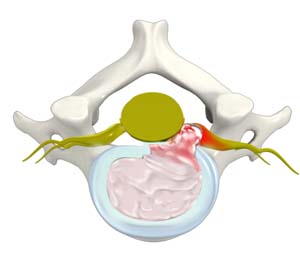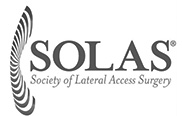Cervical Disc Herniation

Cervical disc herniation can arise due to aberrations of the intervertebral disc such as bulging, rupture and slipped or extruded disc. It results in neck, shoulder and arm pain. In some cases, disc herniation may occur due to injury, repetitive movements or degenerative disc disease (DDD). In DDD the disc strength, resiliency and structural integrity is affected due to advancing age, trauma, injury, smoking, poor diet, improper posture or poor body mechanics.
Each disc is composed of an inflexible ring-like annulus fibrosis enclosing a gelatinous inner structure called the nucleus pulposus. Each disc is kept in position with the help of endplates present between two vertebral bodies. The cervical intervertebral disc acts as a shock absorber. Any cracks or breaks in the annulus fibrosis, which act as a protecting band for the nucleus pulposus, results in oozing of the gelatinous material outside the disc. In a bulged intervertebral disc the nucleus pulposus remains within the disc and acts as a forerunner to herniation. The protruding disc matter causes nerve root and spinal cord compression.
Symptoms
Cervical disc herniation is associated with pain. The degenerative changes in the disc can result in a reduction in disc height which can cause compression of the spinal cord and the spinal nerves. In addition, the exuding disc matter causes pain and inflammation of the nerve due to chemical irritation.
Patients may experience neck pain which may radiate to the shoulder, upper back, hands and fingers; this condition is known as radiculopathy. The other common symptoms associated with cervical disc herniation include:
- Increased pain with movement
- Burning, tingling or numbness
- Stiffness in hand or arm
- Improper balance and gait
- In rare cases, bowel and bladder dysfunction
Diagnosis
An accurate diagnosis is essential for effective and successful treatment.
The diagnosis of cervical disc herniation comprises of the following steps:
- Medical and family history of the patient
- Physical and neurological examinations
- Testing of reflexes to evaluate muscle weakness, sensitivity, and other signs of neurological injury.
- Diagnostic imaging techniques such as X-rays, CT scan, and MRI scans are employed to confirm the location of the damaged cervical disc.
The simple X-ray helps in identifying the collapsed disc space, while CT and MRI scan helps to visualize the bone, disc, nerve and soft tissues.
Treatment
Both surgical and non-surgical methods can be considered in the management of cervical disc herniation. Initially, the doctor may advise non-surgical methods or a combination of two or more therapies to relieve pain and other symptoms. The common non-surgical treatment options include:
- Activity modification
- Medications such as narcotics and muscle relaxants
- Spinal injections
- Use of neck braces to support the cervical spine and relieve pain
- Physical Therapy
- Acupuncture
Surgical treatment is recommended for patients who fail to respond to non-surgical treatment and in patients with associated spinal instability and neurological dysfunction.
In such patients, minimally invasive spine surgery can be performed. Sometimes spinal stabilization and fusion are employed to prevent further deterioration of the condition. Anterior cervical discectomy and fusion (ACDF) is one of the minimally invasive procedures that can be performed to stabilize the neck.
Related Topics:
- Cervical Disc Herniation
- Cervical Myelopathy
- Cervical Stenosis
- Chronic Neck Pain
- Degenerative Disc Disease
- Degenerative Scoliosis
- Herniated Disc
- Kyphosis
- Lumbar Disc Herniation
- Lumbar Radiculopathy
- Sciatica
- Spina Bifida
- Spinal Deformity
- Spinal Stenosis
- Spondylolisthesis
- Spondylolysis
- Vertebral Compression Fractures








